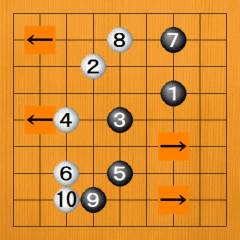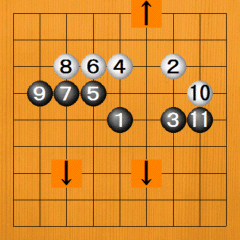 |
[3]The first ten moves

· When you first learn Go, it's hard to know where to play. Let's try to get an image of how to set up your own positions on the board by deciding the direction of play.
· Dia. 9. With 1 and 3, Black is setting up his position on the right side. White builds his position on the left with 2 and 4. Up to 9, Black expands his position on the right side, in the direction of the arrows there. Up to 10, White builds up a position on the left. This is a peaceful game, in which both sides build up their positions without trying to reduce the opponent's position. |
 |

Dia. 9 |
|
· Dia. 10. Black builds up a position at the bottom with 1 to 11. White builds his position at the top with 2 to 10. However, if we compare the two positions, Black's looks bigger. There's no need to count the exact size of Black's position. Just a quick look will show that it's bigger. White had to do something before things progressed this far. Various kinds of plans will be necessary. |
 |

Dia. 10 |
|
· Dia. 11. Black 1, 3 and 5 look like building a large black territory at the bottom. White also gets territory at the top with 2 and 4, but if he keeps playing just at the top with 6, his territory won't bear comparison with Black's, so he needs to find a different strategy for 6. |
 |
Dia. 11
|
|
· (Application) Dia. 12. Plunging in among the black stones with 1 looks good. Even if Black plays 2 at the top, White makes a territory inside Black's territory with 3 and 5. Invading the opponent's position like this is an excellent strategy. In actual games, the black and white stones get mixed up and we get complicated shapes. |
 |
Dia. 12
|
|
 |